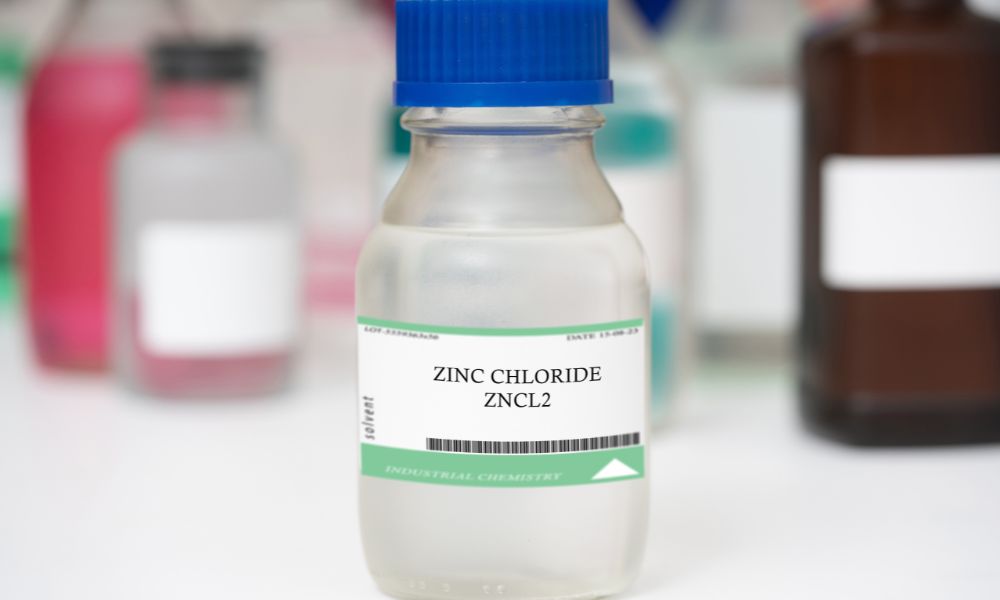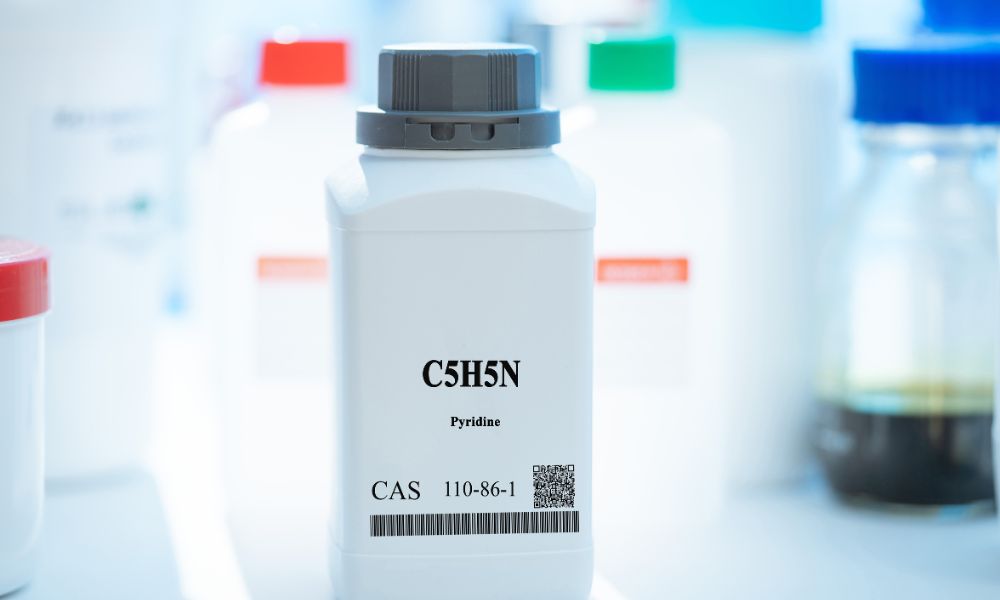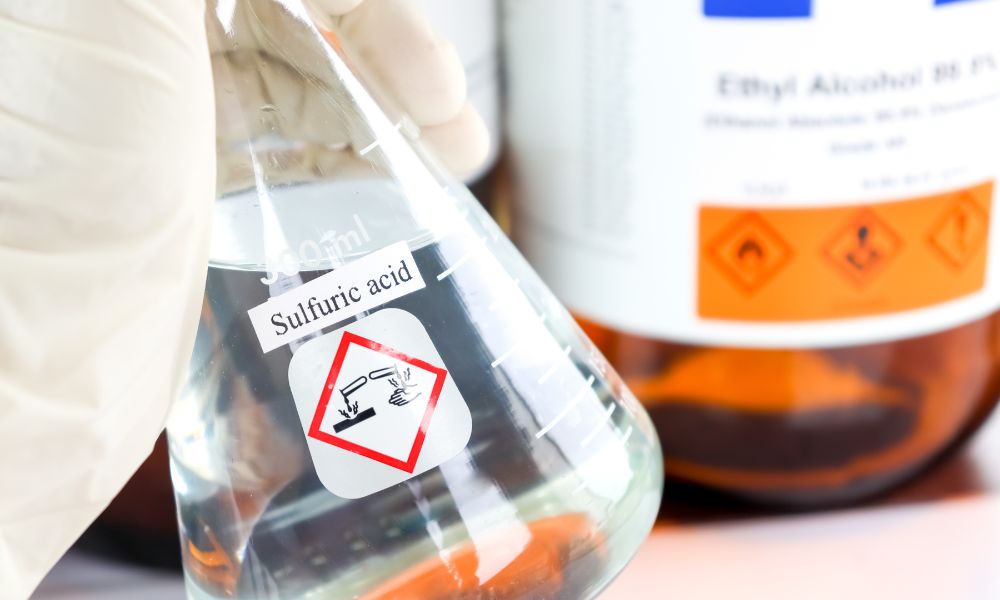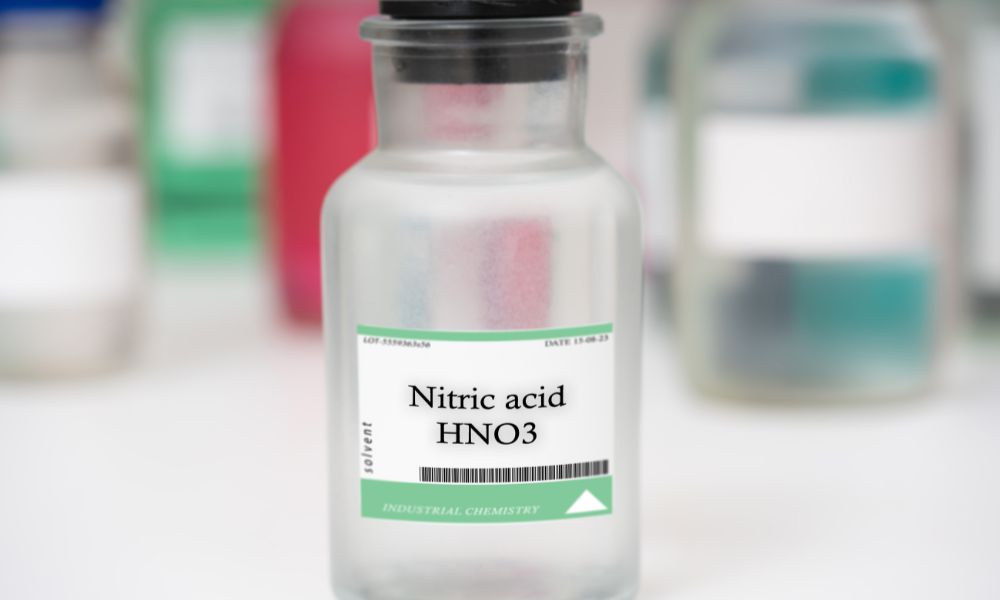Your cart is currently empty!
Author: Andrew Post
-

How Zinc Chloride Is Used in Laboratory Testing
Laboratories are home to many chemicals that power reactions and analyses. One such essential chemical is zinc chloride (ZnCl2). This compound plays a pivotal role in a myriad of laboratory tests, anchoring the reliability and accuracy of findings.
Explore the multi-faceted uses of zinc chloride in laboratory testing, its benefits, applications, and most importantly, how to handle it with caution. Whether you’re a laboratory professional looking to expand your supplies or a prospective chemistry student, you should understand this component and its impact on lab experiments.
Understanding Zinc Chloride
Before exploring zinc chloride’s significance in laboratories, we’ll share its properties and applications. Zinc chloride is a white, crystal-like solid that is soluble in water. Its hygroscopic nature allows it to absorb moisture from its surroundings, making it a key player in various chemical processes.
Properties and Characteristics
Zinc chloride has remarkably high boiling and melting points (1,350 degrees Fahrenheit and 554 degrees Fahrenheit, respectively), showcasing its stability and practicality across various uses in the laboratory. Its hygroscopic nature grants it effective dehydrating functions. Zinc chloride is a key component in various processes that necessitate dry conditions, which we will explore in its lab applications.
Benefits of Zinc Chloride Testing
Using zinc chloride in laboratory testing offers many benefits. Here are some reasons you may want to pick up this compound for your own studies.
Enhances Accuracy
Zinc chloride enhances the precision of titrations and chemical tests. It maintains anhydrous (water-free) conditions crucial for various reactions. Zinc chloride also provides a consistent environment for accurate measurements and observations by ensuring water does not act as a variable.
Improves Reliability of Results
Because it can dehydrate environments, zinc chloride plays an indirect but vital role in maintaining test system integrity. It minimizes the chances of false positives and negatives, which are the bane of any laboratory professional’s work. By creating stable environments, ZnCl2 ensures your results are accurate and trustworthy for further testing.
Offers Cost-Effective Solutions
Zinc chloride is cost-effective because small amounts can go a long way in your experiments. Your lab can rely on this compound to provide the desired effects of the trial without breaking the bank on reagent costs, which is crucial in laboratories with budget constraints. Many suppliers, including Post Apple Scientific, offer zinc chloride and other compounds in bulk, which can help you save on material costs.
Applications of Zinc Chloride in Laboratory Testing
Now that you understand the basics of this material, we can look at the areas within laboratory testing where zinc chloride plays a key role.
Synthesize Organic Products
Zinc chloride is a crucial condensing agent in the lab. Because it promotes chemical transformations in a water-free environment, it’s useful in a wide range of scientific processes. For instance, it aids in producing dyes, phenols, and many organic compounds.
Particularly significant in pharmaceuticals, cosmetic chemistry, and material science, ZnCl2 is pivotal for orchestrating organic reactions in a controlled, dehydrated setting.
Manufacture Chemicals and Solvents
This material also works as a starting ingredient for various chemicals and as a solvent in fluxes and metallurgical applications. Due to its safety profile and reliability, zinc chloride is common in many manufacturing processes. Zinc chloride is even popular for making batteries and as an electrolyte for galvanizing other metals.
Disinfecting and Dehydration
Zinc chloride acts as a disinfectant by denaturing proteins, making it an effective mineralizing agent for organic tissues. This also makes it ideal for preserving biological samples. Medical laboratories often use this material for preparing tissue specimens for microscopy due to its dehydrating nature.
Electrolytes in Dry Cells
Zinc chloride plays a role as an electrolyte, providing ionic conductivity in dry cell batteries. Its long storage times and low self-discharge make it ideal for crafting batteries and other manufacturing goods. Its low conductivity in water solutions makes it viable for electrolyte solutions, providing the necessary charge-carrying functions without causing unwanted reactions with other chemicals.
Safety Precautions for Working With Zinc Chloride
While ZnCl2 can be a boon to your laboratory, it’s imperative to handle it with care. Here are some handling guidelines and safety precautions your lab staff should follow when working with zinc chloride.
Potential Hazards and Precautions
Zinc chloride is corrosive and can cause severe burns on contact with the skin or eyes. Inhalation can lead to respiratory irritation, and ingestion may cause gastrointestinal distress. Laboratory professionals of all levels should use caution and follow their facility’s safety procedures while handling zinc chloride. In case of contact with the skin or eyes, thoroughly wash the affected area with water, and seek medical attention if necessary.
Handling Guidelines
When working with zinc chloride, you must wear appropriate personal protective equipment (PPE), including gloves, goggles, and lab coats. Always work in a ventilated area, as the compound can cause irritation in the respiratory tract.
Safe Storage
Store zinc chloride in a dry place away from direct sunlight and incompatible materials to prevent unwanted reactions. Also, keep it in an airtight container to prevent moisture absorption.
Your chemical supplier and the labeling on the product itself will provide detailed storage instructions. When you order your chemicals and solvents from a trusted supplier, you will notice clear labeling and handling instructions on the products. If you’re wondering where to buy zinc chloride, you’ve come to the right place. Post Apple Scientific offers high-quality, lab-grade chemicals, solvents, and a variety of other supplies.
Zinc chloride’s reliable performance in a variety of laboratory tests, comprehensive applications, cost-effectiveness, and contributions to the accuracy of test results make it a must-have chemical component.
Understanding the benefits of zinc chloride and its role in laboratory testing can make your processes more effective. Post Apple Scientific takes pride in being part of the laboratory supply chain, providing quality ZnCl2 and other laboratory reagents to promote high-quality studies and scientific discoveries.
Browse our website to learn more about the role of zinc chloride in laboratory testing or explore our range of chemicals and labware. We’re dedicated partners in your laboratory’s success and ensuring your studies have a strong, reliable foundation.

-

Handling Pyridine: Best Practices and Precautions
Laboratory personnel often work with highly reactive substances and noxious fumes. Pyridine is an example of a reactive chemical that scientists and laboratory professionals use for many applications. Explore the best practices and precautions for working with pyridine to protect yourself and your team while handling this potentially hazardous material.
What Is Pyridine?
Pyridine is a common solvent and base reagent for synthesizing pharmaceuticals, agrochemicals, and industrial chemicals. It can undergo various reactions to create complex compounds. Pyridine is known for its strong fishy odor and several hazardous properties.
Using pyridine is generally unproblematic if you follow your lab’s safety guidelines. However, skin contact, ingestion, or inhalation can cause severe health issues, such as nausea, coughing, wheezing, and abdominal pain. It is a hazardous waste material with strict usage and handling procedures due to its potential side effects.
Best Practices for Handling Pyridine
Your lab should be ventilated before you or anyone else handles pyridine. When working with this chemical, be mindful of its volatile nature; keep containers tightly closed, and only use the chemical in certified fume hoods.
Remember to store pyridine in a cool, dry place, away from ignition sources. Per OSHA laboratory safety guidelines, containers for hazardous chemicals such as pyridine must have labels. Always store pyridine containers in a ventilated, cool environment away from humidity and temperature extremes. Keep in mind that pyridine can absorb water from the atmosphere, reducing its solvency strength over time.
Precautions for Working With Pyridine
Personal protective equipment is non-negotiable when handling pyridine. Wear chemical splash goggles, a lab coat, and gloves made of nitrile or neoprene, not latex. In case of eye or skin contact, flush the affected area with water for at least 15 minutes, then seek medical attention.
Inhaling pyridine fumes, even at low levels, can lead to headaches, dizziness, and respiratory irritation. Ingestion of pyridine can be life-threatening. Always walk your lab staff through these precautions, and avoid eating and drinking in the laboratory to reduce the chances of chemical ingestion.
Working with pyridine demands unwavering adherence to workplace safety protocols. These guidelines for handling pyridine are crucial for all laboratory staff to follow. Always stay vigilant in the lab when working with chemicals and solvents, and always use professional-grade materials. If you’re looking for professional-grade pyridine for your lab applications, you can find pyridine ACS wholesale at Post Apple Scientific. We offer a wide range of laboratory-grade chemicals and solvents for various lab applications. Browse our website to learn more.
-

What Makes Anhydrous Caffeine Different?
Caffeine is a familiar stimulant to many. However, anhydrous caffeine is a form of this compound that you may not recognize in laboratory content. When conducting scientific research and pharmaceutical applications, understanding the nuances among different chemical formulations of caffeine is essential. Keep reading to discern anhydrous caffeine’s distinct properties and applications, including how it differs from other forms of caffeine.
Anhydrous Caffeine by Definition
Anhydrous caffeine, a dehydrated form of caffeine, is essentially caffeine without water. The term anhydrous means “without water,” referring to the absence of water molecules. This formulation is a highly concentrated caffeine powder.
How Is Caffeine Anhydrous Different?
The biggest distinction between anhydrous caffeine and its hydrated counterparts is its lack of water. Unlike the caffeine in coffee beans and tea leaves, which contain water molecules, manufacturers process anhydrous caffeine to remove moisture. This dehydration process results in a refined, more potent product.
The anhydrous form also provides greater storage stability and versatility in dosage formulation. Users can precisely measure anhydrous caffeine, which makes it ideal in scenarios where control and exact dosage are crucial.
Applications and Benefits of Caffeine Anhydrous
Now that you know what makes anhydrous caffeine different than its other forms, you can see why it has unique applications. Here are some of these different applications and the benefits of using caffeine anhydrous:
- Precision in research: When conducting experiments that involve caffeine, many researchers prefer the anhydrous form due to its measurement accuracy. Hydrates can vary in water content, introducing variability; anhydrous caffeine offers uniformity in research protocols.
- Pharmaceutical use: Anhydrous caffeine is also ideal in pharmaceutical studies for its consistent properties. It is integral in creating various medical and health products, including diuretics, pain relief medications, and stimulants.
- Supplements and nutraceuticals: Anhydrous caffeine is a popular ingredient in many fitness and supplement products. It is a staple ingredient in pre-workout mixes and weight loss pills where precise and impactful doses of caffeine are warranted.
- Longevity of the product: The absence of water ensures you can store anhydrous caffeine for extended periods without the risk of degradation due to moisture. This contributes to both cost-effectiveness and reliability in long-term applications.
These are some of the various ways caffeine anhydrous differs from its other forms. The unique characteristics of anhydrous caffeine—from its potent concentrated form to its stability and versatility—make it valuable to many pharmaceutical and scientific industries. If your business belongs to one of these industries and you would like to take advantage of the benefits of anhydrous caffeine, you can learn more about this product today at Post Apple Scientific. As a lab supplier, we offer pharmaceutical-grade caffeine anhydrous USP for many different industries. For those invested in the accuracy and efficacy of their work, Post Apple Scientific stands ready to supply anhydrous caffeine, among other paramount laboratory requisites.
-

How To Neutralize Sulfuric Acid Solutions
All professionals who work with chemicals must understand the importance of safety and proper handling. Sulfuric acid is one common chemical that requires careful attention as it is a highly corrosive and hazardous substance. Because this chemical can be hazardous, it requires careful handling and preparation for disposal.
Neutralizing sulfuric acid solutions is a crucial step in managing chemical spills, preventing environmental damage, and ensuring the safety of laboratory professionals and manufacturers. Understanding the properties of sulfuric acid and the neutralization process is essential for anyone working with this potent substance. Learn how to neutralize sulfuric acid solutions safely and effectively to properly handle and dispose of them in your laboratory or other workplace.
What Is Sulfuric Acid?
Sulfuric acid is a highly potent and corrosive substance that is infamous for its aggressive properties, including its highly corrosive elements and health hazards. This strong acid is highly reactive to a wide range of materials, including metals, organic compounds, and even some nonmetals. Its caustic nature means it can cause severe burns upon direct contact with the skin, leading to long-lasting tissue damage. Moreover, sulfuric acid’s toxic fumes pose significant risks to human health and the environment, necessitating utmost caution and adherence to proper handling protocols. Neutralizing this hazardous substance is of utmost importance to create and maintain a safe working environment, ensuring the well-being of individuals and safeguarding the integrity of surrounding structures and equipment.
What Is the Neutralization Process?
Neutralization is an essential chemical reaction that results when combining an acid with a base, creating a type of salt and water. This process neutralizes the acidic properties of the solution, mitigating its potential hazards. We can reduce sulfuric acid’s acidity and eliminate the risks of handling and disposing of it by introducing a suitable neutralizing agent to a sulfuric acid solution. Doing so ensures a safer working environment and contributes to the efficiency and effectiveness of the chemical processes involved.
Why Is It Important To Neutralize Sulfuric Acid?
Neutralizing sulfuric acid solutions serves multiple purposes. We minimize the risk of accidental spills and exposure to highly corrosive substances by carefully neutralizing these solutions with suitable bases such as sodium hydroxide or calcium carbonate. Neutralizing hazardous sulfuric acid solutions also safeguards your equipment’s integrity, infrastructure, and the environment. This crucial step ensures the long-term durability and functionality of storage containers, transport systems, and other critical components handling and storing sulfuric acid. Additionally, neutralization plays a significant role in maintaining the pH balance of wastewater treatment systems, preventing adverse effects on aquatic life and ecosystem health. Thus, we contribute to a safer and more sustainable local environment by neutralizing sulfuric acid solutions effectively.
What Neutralizes Sulfuric Acid?
Several agents can effectively neutralize sulfuric acid solutions. Some common neutralizing agents include sodium bicarbonate, calcium carbonate, and sodium hydroxide. Each neutralizing agent has its advantages and considerations, so it is important to choose the appropriate agent based on the specific situation. Which neutralizing agent you choose depends on factors such as the acid’s concentration percentage. It is important to select an appropriate neutralizing agent and follow the recommended proportions for effective neutralization.
Neutralization Methods for Sulfuric Acid Solutions
Follow these basic steps to safely neutralize sulfuric acid solutions:
- Prepare a neutralizing solution by carefully dissolving a precisely measured amount of the chosen neutralizing agent in water. Doing so ensures the correct concentration for effective neutralization.
- Gradually and slowly add the prepared neutralizing solution to the sulfuric acid solution. Stir continuously during this process to facilitate thorough mixing and reaction between the two substances.
- Regularly monitor the pH level using either pH paper or a pH meter. These pH monitors allow you to track the neutralization progress and achieve the desired pH level. This portion of the neutralization process requires your time and patience.
- Once the neutralization process is complete and your solution reaches the desired pH level, adhere to local regulations when disposing of the neutralized solution. Every laboratory and manufacturing facility using chemicals should understand the local disposal laws and guidelines to maintain safety and legal compliance.
You can effectively neutralize sulfuric acid solutions while prioritizing safety and environmental responsibility by following these steps.
Common Neutralization Mistakes To Avoid
While neutralizing sulfuric acid solutions, be aware of common mistakes that can compromise safety. Some common mistakes to avoid during the neutralization process include:
- Never add the neutralizing agent too quickly, as doing so can lead to excessive heat generation and potential splattering.
- Never use an incorrect quantity of neutralizing agent, as it can result in incomplete neutralization or an over-neutralized solution. Always carefully measure your neutralizing agent and compare it with supplier guidelines for neutralization.
- Never skip testing the pH level during the neutralization process. Skipping this step can lead to inaccuracies and potential hazards.
Neutralizing Sulfuric Acid on Different Surfaces
The neutralization process may vary depending on the surface or material that encounters sulfuric acid. For example, sulfuric acid may react differently when contacting various materials, such as concrete, metal, plastic, and skin. A two-step process involving rinsing and neutralization is often necessary to ensure complete and safe neutralization.
Safety Tips for Working With Sulfuric Acid
Working with sulfuric acid requires strict adherence to safety precautions. Always wear appropriate personal protective equipment (PPE) such as gloves, goggles, and a lab coat. Work in a well-ventilated area to minimize exposure to acidic fumes. Ensure you are familiar with emergency protocols and have access to safety showers and eyewash stations. Prioritize safety to minimize risks associated with handling sulfuric acid.
Here are some additional safety tips to keep in mind when working with sulfuric acid:
- Store sulfuric acid in a well-ventilated area, away from incompatible substances.
- Handle sulfuric acid containers with care, ensuring you seal them tightly and properly label them.
- Always add acid to water when diluting concentrated sulfuric acid to avoid splashing or violent reactions.
- Dispose of waste solutions following local regulations and guidelines.
- Regularly inspect and maintain storage and handling equipment to prevent leaks or spills.
Neutralizing sulfuric acid solutions is a critical step in ensuring safety and minimizing environmental impact. You can handle and dispose of sulfuric acid solutions safely and responsibly by following these steps to neutralize sulfuric acid, adhering to safety precautions, and avoiding common mistakes. Remember to prioritize safety and consult experts or professionals when dealing with large-scale neutralization processes. You contribute to a safer working environment and help protect our surroundings from the potential hazards of sulfuric acid by doing so.
Obtaining your chemicals from a reputable and experienced source is key when working with hazardous acids like this. Trust Post Apple Scientific as your supplier if your business is looking for a reliable source for where to buy sulfuric acid. Browse our selection of chemical agents today to learn more about sulfuric acid and its properties.

-

Understanding the Oxidizing Power of Nitric Acid Solutions
The field of chemistry is complex, so categorizing the chemical reactions that take place can help your lab stay organized and safe. One of the chemical properties to record is oxidizing power, which describes a chemical’s ability to transfer electrons from one substance to another. Keep reading to delve into the oxidizing power of nitric acid solutions and explore their applications in various industries, including laboratories, manufacturing facilities, and more.
How To Determine Oxidizing Power
The oxidizing power of a substance describes how easily it causes other substances to lose electrons in a chemical reaction. Scientists can measure this using established scientific methods such as redox potential (the tendency of a substance to acquire electrons in a redox reaction) or by comparing standard electrode potentials. The greater the tendency to accept electrons, the stronger the oxidizing agent. In other words, the agent has a high oxidizing power.
Nitric Acid’s Oxidizing Power
Nitric acid (HNO3) is an essential substance in the realm of oxidizing agents. It is a strong, corrosive, inorganic acid that is colorless when pure, but typically appears as a yellowish solution due to impurities. Nitric acid solutions exhibit remarkable oxidizing power due to the oxidation state of nitrogen, making it an excellent electron acceptor. This occurs when nitric acid dissociates in an aqueous solution, generating free hydrogen ions and nitrates, accompanied by the transfer of electrons.
Benefits of Using Nitric Acid Solutions
Nitric acid’s potent oxidizing power makes it a valuable and versatile tool in several industrial and scientific processes. Its applications span from metal refining, where it can help process and dissolve metals, to analytical chemistry, where it can oxidize organic compounds for qualitative and quantitative analysis.
Nitric acid solutions are also a common material in fertilizer production, as the nitrates formed are essential for plant growth. In organic synthesis, nitric acid serves as an oxidizing agent in various chemical reactions, such as aromatic compound nitration or alcohol oxidation.
Despite the numerous benefits offered by nitric acid solutions, they must be handled with care due to their highly corrosive nature and ability to produce toxic fumes when in contact with various substances. Proper personal protective equipment, ventilation, and containment measures are essential when working with nitric acid to mitigate associated risks and potential hazards. You should only buy nitric acid from trusted suppliers to ensure you’re working with quality products that manufacturers handle properly.
The oxidizing power of nitric acid solutions is vital to a broad range of scientific and industrial applications. Understanding this property enables scientists, researchers, and manufacturers to harness nitric acid’s full potential, contributing to advancements in chemical research and technological innovation. However, nitric acid’s potency also demands responsible handling and adherence to safety protocols to minimize risks, so always stay up to date with safety protocols and choose a reputable supplier like Post Apple Scientific.
-

Understanding the Application of Reagents in Laboratories
Laboratories everywhere constantly work toward innovation and discovery. Some of the most crucial materials for laboratory studies are reagents, which assist researchers in unlocking the mysteries of chemical interactions. Understanding the role of reagents and their various applications in laboratories can provide a comprehensive insight into laboratory operations.
Detecting Substance Presence in Solutions
Thanks to their unique properties, reagents play a critical and indispensable role in detecting the presence of specific substances in solutions. Certain reagents can cause a distinctive and visually striking color change when they encounter chemical compounds, providing a clear indication of the compound’s presence. This application of reagents is particularly crucial in areas like environmental testing, such as when ascertaining the presence of pollutants in water samples. Environmental tests like this help ensure the safety and well-being of our ecosystems. By leveraging the power of reagents, scientists and researchers can uncover valuable insights and make informed decisions about the contents and safety of samples.
Synthesizing New Compounds
Reagents are crucial in facilitating the synthesis of new compounds by providing the necessary conditions. This ability is critical for a wide range of applications, including creating life-saving pharmaceutical drugs and developing innovative materials in various industrial settings. Precisely selecting and utilizing reagents enables scientists and researchers to achieve remarkable advancements and breakthroughs, paving the way for improved healthcare, sustainable technologies, and a better understanding of the world around us.
Researching the Reactions Between Chemical Compounds
In the realm of research, reagents are fundamental tools for uncovering how different chemical compounds react. By providing a controllable and predictable manner to initiate chemical reactions, reagents let scientists investigate and understand the dynamic world of chemistry at a molecular level.
Testing Samples and Making Diagnostics
In healthcare laboratories, reagents play a crucial role in testing patient samples and enabling accurate diagnostics. Researchers employ these essential substances in various applications, such as immunoassays, in which reagents help detect disease markers present in blood samples. Additionally, scientists use reagent strips for urinalysis, providing immediate results for a wide range of health-related indicators, including glucose levels, urinary tract infections, and kidney function. By facilitating precise and efficient testing, reagents contribute significantly to the overall quality of healthcare outcomes.
Reagents are unsung heroes in laboratories, contributing to advances in diverse fields, from environmental science to healthcare. While often overlooked, their essential role in chemical reactions and diagnostics underpins much of the progress we see in science and technology today. Now that you understand the application of reagents in laboratories and their wide range of processes, you may be curious about where to buy chemical reagents for your own professional use. Browse our selection of chemical reagents at Post Apple Scientific today to find high-quality materials to support a variety of industries and laboratory studies.
-

The Impact of Impurities in Lab Chemicals
Laboratory technicians and scientists depend on the accuracy of their materials and equipment to ensure success in their projects. One crucial aspect of this accuracy is maintaining the purity of lab chemicals. Impurities in lab chemicals can have a significant impact on experiments, as they can influence the results of chemical reactions and research findings. Explore the impact of lab chemical impurities and their effects on scientific experiments, and learn effective strategies for minimizing impurities in lab chemicals to safeguard the integrity of your research results.
Impurities Can Impact Chemical Reactions
Impurities in lab chemicals can impact chemical reactions in numerous ways. For example, unwanted contaminants can induce unexpected side reactions, forming undesirable or unstable products. These impurities can also interfere with the intended reaction, resulting in skewed or incomplete results that may compromise the validity of experimental conclusions.
Impurities Can Influence Research Findings
Moreover, impurities in lab chemicals can have far-reaching consequences regarding research findings. First, contaminants may produce false positives or negatives, causing researchers to draw erroneous conclusions from their experiments. This can hinder the progress of future research projects and lead to recording inaccurate information. Additionally, impurities can obstruct the reproducibility of experiments, which is a critical aspect of the scientific method that ensures the reliability of research results.
How To Minimize Impurities in Lab Chemicals
Now that you understand the implications of impurities in lab chemicals, adopting effective strategies to minimize their presence in scientific experiments is essential. One such approach is to prioritize proper storage techniques for lab chemicals. By storing chemicals in appropriate containers and temperature-controlled environments, researchers can significantly reduce the risk of contamination from external sources. Furthermore, regularly monitoring and testing lab chemicals can help identify impure chemicals and prevent their use in critical experiments.
Sourcing your laboratory’s chemicals through reputable suppliers can also help minimize the risk of impurities and contamination. If you’re looking for a trustworthy supplier of chemicals for sale, browse our selection at Post Apple Scientific. We carry lab-grade chemicals for scientists, technicians, educational facilities, and more.
The impact of impurities in lab chemicals as they relate to scientific research and experiments is a significant concern that lab professionals must manage effectively. By understanding contaminants and their effects and adopting best practices to minimize their presence, laboratory technicians and researchers can protect the integrity of their work.
-

Pyridine and Its Role in Analytic Chemistry
Acknowledging the various chemical compounds that play a critical role in various processes is important when exploring the analytical chemistry field. Pyridine is one such compound. This short guide will explore pyridine and its role in analytic chemistry, its properties, benefits, and the crucial safety precautions to keep in mind when working with this chemical compound.
Understanding Pyridine
Pyridine is a colorless, flammable, organic compound comprised of a six-membered ring with five carbon atoms and one nitrogen atom. Pyridine’s unique property is its ability to hold a positive charge, allowing it to participate in reactions as a nucleophile or base.
The Role of Pyridine in Analytic Chemistry
The most significant role pyridine plays in analytical chemistry is as a solvent. Due to its high boiling point and excellent solvency, pyridine can efficiently dissolve various chemical substances. Furthermore, its chemical stability makes it less reactive and allows for safe use with other chemicals. Thus, pyridine is a popular solvent choice, especially for conducting chemical reactions in the presence of water-sensitive compounds.
Additionally, pyridine is a valuable reactant in various chemical transformations. It can act as a catalyst, expediting the reaction process, without being consumed. Synthetic chemists have used pyridine for years in the pharmaceutical, agrochemical, and polymer industries to produce essential chemicals and materials.
Benefits of Using Pyridine in Chemistry Reactions
Using pyridine in chemistry reactions comes with several benefits. Its properties make it a versatile chemical, capable of participating in numerous chemical processes. Pyridine is a widely accessible and cost-effective alternative to other solvents. Moreover, its ability to act as a catalyst in various reactions makes it an essential component in chemical transformations.
Safety Considerations When Using Pyridine in Analytic Chemistry
Despite pyridine’s extensive functionality in analytical chemistry, it is crucial to exercise caution when using this compound. Pyridine is highly toxic. Prolonged or repeated exposure can lead to severe health hazards.
Always wear appropriate personal protective equipment, including gloves, eye protection, and lab coats when working with pyridine. Additionally, ensure proper ventilation in the working area to minimize inhaling harmful pyridine vapors. Finally, dispose of pyridine waste and contaminated materials in accordance with environmental regulations to prevent environmental pollution and potential hazards.
Pyridine and its role in analytic chemistry offers many advantages in chemical reactions, whether you use it as a solvent, reactant, or extraction agent. Post Apple Scientific is the Pyrindine ACS supplier you’ve been looking for if you’re interested in using pyridine for your chemical lab experiments. Browse our selection of solvents and chemicals today for more information.